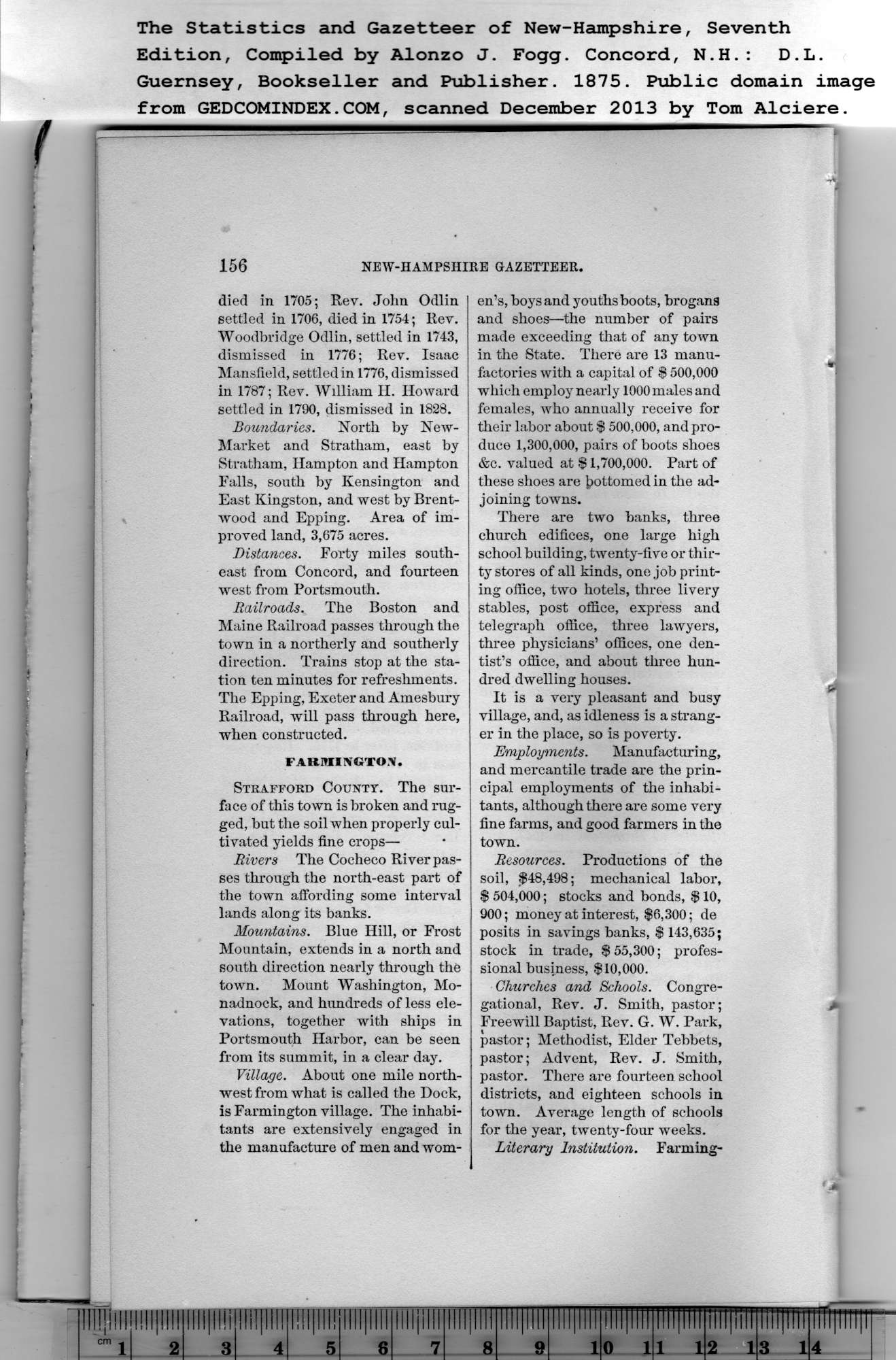|
died in 1705; Rev. John Odlin
settled in 1706, died in 1754; Rev.
Woodbridge Odlin, settled in 1743,
dismissed in 1776; Rev. Isaac
Mansfield, settled in 1776, dismissed
in 1787; Rev. William H. Howard
settled in 1790, dismissed in 1828.
Boundaries. North by New-
Market and Stratham, east by
Stratham, Hampton and Hampton
Falls, south by Kensington and
East Kingston, and west by Brent-
wood and Epping. Area of im-
proved land, 3,675 acres.
Distances. Forty miles south-
east from Concord, and fourteen
west from Portsmouth.
Railroads. The Boston and
Maine Railroad passes through the
town in a northerly and southerly
direction. Trains stop at the sta-
tion ten minutes for refreshments.
The Epping, Exeter and Amesbury
Railroad, will pass through here,
when constructed.
FARMINGTON.
Strafford County. The sur-
face of this town is broken and rug-
ged, but the soil when properly cul-
tivated yields fine crops—
Rivers The Cocheco River pas-
ses through the north-east part of
the town affording some interval
lands along its banks.
Mountains. Blue Hill, or Frost
Mountain, extends in a north and
south direction nearly through the
town. Mount Washington, Mo-
nadnock, and hundreds of less ele-
vations, together with ships in
Portsmouth Harbor, can be seen
from its summit, in a clear day. |
Village. About one mile north-
west from what is called the Dock,
is Farmington village. The inhabi-
tants are extensively engaged in
the manufacture of men and wom-
en’s, boys and youths boots, brogans
and shoes—the number of pairs
made exceeding that of any town
in the State. There ai’e 13 manu-
factories with a capital of $ 500,000
which employ nearly 1000 males and
females, who annually receive for
their labor about $ 500,000, and pro-
duce 1,300,000, pairs of boots shoes
&c. valued at $ 1,700,000. Part of
these shoes are bottomed in the ad-
joining towns.
There are two banks, three
church edifices, one large high
school building, twenty-five or thir-
ty stores of all kinds, one job print-
ing office, two hotels, three livery
stables, post office, express and
telegraph office, three lawyers,
three physicians’ offices, one den-
tist’s office, and about three hun-
dred dwelling houses.
It is a very pleasant and busy
village, and, as idleness is a strang-
er in the place, so is poverty.
Employments. Manufacturing,
and mercantile trade are the prin-
cipal employments of the inhabi-
tants, although there are some very
fine farms, and good farmers in the
town.
Resources. Productions of the
soil, $48,498; mechanical labor,
$ 504,000; stocks and bonds, $ 10,
900; money at interest, $6,300; de
posits in savings banks, $ 143,635;
stock in trade, $ 55,300; profes-
sional business, $10,000.
Churches and Schools. Congre-
gational, Rev. J. Smith, pastor;
Freewill Baptist, Rev. G. W. Park,
pastor; Methodist, Elder Tebbets,
pastor; Advent, Rev. J. Smith,
pastor. There are fourteen school
districts, and eighteen schools in
town. Average length of schools
for the year, twenty-four weeks.
Literary Institution. Farming- |
